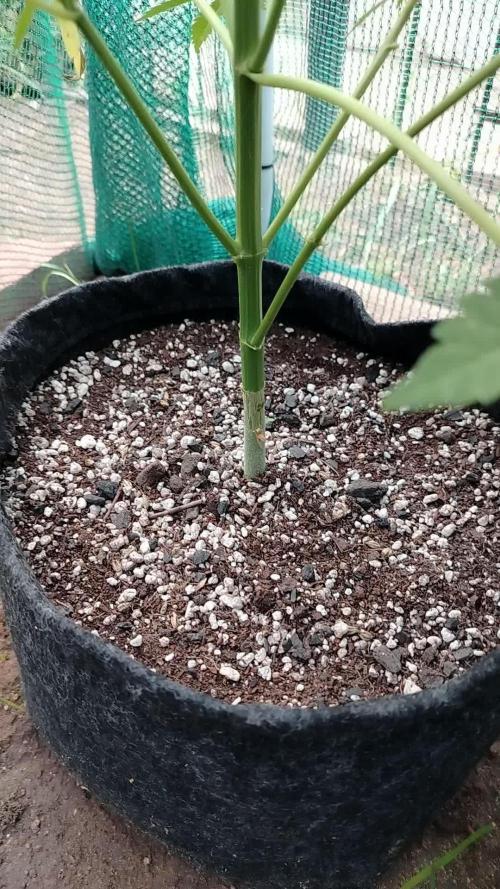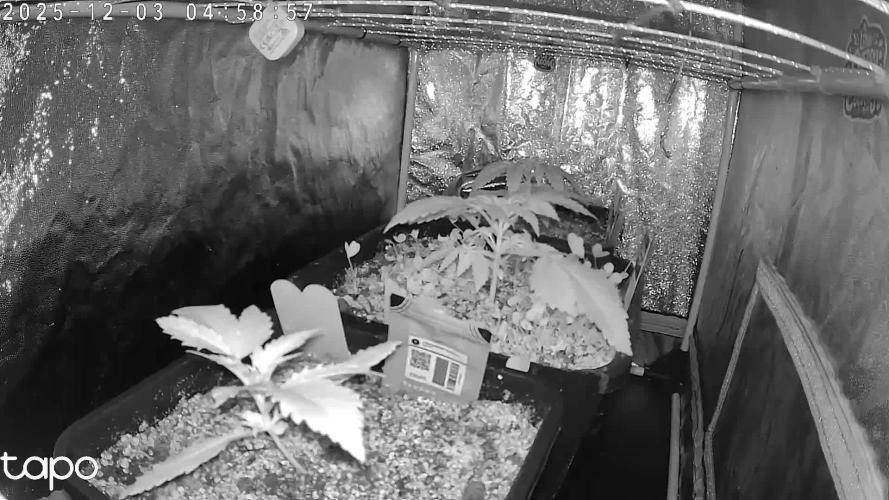The Grow Awards 2026 🏆 





























Likes
Comments
Share


@Bread_n_Buds
Follow
Here we are at the halfway point, after the first month our photoperiod plants are multiplying their florets and then going into flowering.
Jet Fuel has just undergone the topping of 8 florets, you can see the 4 fresh florets just cut. We are therefore at 8 very small branches growing, my plan for photoperiod plants is to get to 16, wait a few days and go into flowering. 16 florets as I see it is the perfect size for the 11 liter pot.
Topping is an extremely delicate moment as regards cutting the florets to split them, we always take care not to damage the new growing florets.
Topping is also a delicate moment as regards fertilization because the plant slows down and absolutely does not need all that nitrogen that it would normally need and that the producers recommend in their sheets. So you should arrive with the plant green and in perfect shape at this moment and dose the fertilizer very well for growth.
Mine came from a slightly deficient veg because I kept it low fearing this over effect during the topping that I know well and now I'm a bit over. Nothing to worry about, of course, but if you do repeated topping my advice is to use preferred soil or prepare the soil with Monster Bud Mix by Zamnesia or Plagron Super Mix, in short, enrich the soil and start and only add nitrogen if necessary, especially during repeated topping.
In any case, everything is under control and I will demonstrate it to you during the flowering phase. Wait for the Uncle BreadandBuds and see what it does to you.
Remember the cold temperature makes the girls absorb food much more slowly than in summer so be careful to give the right amount and to dry the plant in maximum 2 days or you risk imbalances.
We are always using soil, feeding and all the recommended additives from Plagron 100& organic we have only lowered the amount of grow in this topping phase for the reasons given above.
---- Decide on the right soil and calculate your fertilizer card based on the soil on the official website.
-- www.plagron.com
Try a seed of this strain that drives us crazy...
---- https://www.zamnesia.io/it/11258-zamnesia-seeds-jet-fuel.html
Zamnesia Description // Jet Fuel (also known as G6, Jet Fuel OG, and G6 Kush) is a modern hybrid rich in THC and terpenes with a diesel aroma. Originally created in Colorado by crossing Diesel with Aspen OG, this 60% sativa-dominant hybrid is a must-have for any smoker who enjoys an uplifting and energizing high. Now, thanks to the hard work of our breeders, the original Jet Fuel is even easier to grow at home. Order your seeds, plant them in soil, and enjoy their rapid growth. After just 9–10 weeks of flowering, you can expect a generous harvest of premium sativa buds!
All the best that mother nature can offer is on —— www.zamnesia.com
*Sorry I Don’t know why I dont find the white background photo only for this strain
Likes
14
Share


@Bigbombbudz
Follow
Hey here we go again.. in the pics I explained how to clean the lava rocks but to make it easier I will put them here.
LAVA ROCK CLEANING.
1... fill sink with hot water and about a half bottle of hydrogen peroxide .
2 ...dump rocks into sink
3....shake out rocks from roots...I suggest you do this in another sink then add lava rock to other sink..it keeps from adding to many roots to water sink.
4....skim off all roots from top of water...now while the lava rocks sit in the water..clean the buckets.
5...take fitting from buckets and add to a cup filled with hydrogen peroxide let sit
6...clean buckets with hot water and hydrogen peroxide....dry bucket
7...take fittings out of cup clean off and clean inside fittings..then wash off and put back into buckets.
8... use a colander and add lava rock to it and run hot water over the lava rock as you move them around...then add warm..then cold water this will help make the roots brittle and easy to remove...shake off all water.
9...put rocks back into buckets
10 ...set room back up with all new lines...
Enjoy your grow, good luck, have fun
Smoke a fatty..see you next week
Help out a fellow grower.
Processing
Likes
2
Share


@Patillac31
Follow
●Day 49, end week 7. Added bembe, Boomerang, and blackstrap molasses to the diet. Noticed some brown freckles on a handful of leaves. Hopefully the cal and mag in the molasses will help get me through another week before the big flush🤞 recalibrated my p.h. meters. On to week 8
●Day 44 just picked up a new microscope (Wireless Digital Microscope, ROTEK 50x and1000x Microscope Magnification with HD 1080P 2MP Camera, Mini Pocket Handheld Microscope Camera with Light Compatible for iPhone Android, iPad Windows Mac) via Amazon. So, sorry for the blurry trichome pics. I'll work on it. This diary will focus primarily on Big Bud by Seedstockers for the remainder. But the agent orange will finish her journey. Pretty pleased with how things are going. Any suggestions or comments are always appreciated. Happy Gardening ✌️🌱🤙🖖
Likes
11
Share


@LaughingDragon
Follow
Quite the week, finally got to transplant into a larger container, hopefully the roots open up and explore soon. First round of LST completed as well.
Likes
13
Share


@cookingwithninja
Follow
Week 9 day 1 video pheno.
Gonna chop this week
Week 9 day 7 well chop this weekend so on week 10 Day 1-2. Just waiting on a light to reveg one.
Everything is magic
Likes
4
Share


@iopiopiop
Follow
This is my first week of flush!
Day 1 of week 13: Today I first watered 0.5l of tap water with a ph of around 8. Since there is minimal runoff I decided to water another 0.5l of decholrinated water with a ph of 7 for a total of 10% of the pot volume. Runoff was around 10% of that litre. From now on I think I will be watering less often at around 0.5-1 litre at a time. (with enough time for the medium to dry out in between PS: The sun will definitly help with that). I also water twice to keep the ph value of the medium in check without needing to use up all of my destilled water.
Day 2: Plant was way to wet to water so I left her.
Day 3: Earth has already dried out completely and I watered with 0.5 litres of distilled water.
Day 4: 50/50 mix of distilled/tap water (250ml/250ml)
Day 5: Plain tap water (1.25 litres) [todays temp: 37 degrees]
Day 6: No water
Day 7: Plain tap water (1.25 litres) [todays temp: 32 degrees]
Likes
Comments
Share


@soil2bud
Follow
These ladies have just taken off and doing what they must... I started the BioBloom feeding today and did a very light defoliation
Likes
13
Share


@NanoLeaf
Follow
Overall great strain to grow, and the smell is probably my all time favourite for this entire grow. Almost cookie dough - like!
Smoke is smooth and very uplifting.
I felt like I was a moon rock floating in space :)
Likes
104
Share


@SmokingTiki
Follow
The plants keep growing and the first pistils have appeared a little bit more than one week after the 12h/12h switch.
It looks like some of the leaves close to the fan received too much wind so I moved the fan to the other side of the crop to see if it's better, it seems to work.
The Blackberry Cake branches grew much this week and unfortunately I didn't see that the LST strings were too tight 😒 Now I removed them but they left some marks on the branches. It already happened to me with previous grows but the plants recovered 😎
It has been two weeks since the 12h/12h switch, I think I can expect some small flowers during next week 👊
Plants heights at the end of the week :
-------------------------------------------
Blackberry Cake : 50 cm
Jack Herer : 47 cm
Cashew Kush : 56 cm
Likes
15
Share


@valiotoro
Follow
Hello everyone😎
Week 5 of flower for the LCC🍋🍒🍪
It’s almost the end!
One more week for the top buds to be ready✂️
The smell is amazing lemon zest & rippen cherry super sweet🤤
One more feeding with Green Sensation etc then flush.
Likes
3
Share


@Passionatos
Follow
This week I’m defoliated the baby’s hard so all the nuggs are getting light
Likes
2
Share


@ChitownCannaChica
Follow
Did this lady in a shared DWC bucket.
Great auto yield. No herming and beautiful red buds.
Gave the floraflex lineup from veg to bloom.
Had some issues with leaves burning up close to the lighting but the buds are a beautiful color and smell like a nice piney gas.
Cannot say anything but great things with this plant! Very happy and results are great.
Likes
15
Share


@Rebola
Follow
05/07/2021
Big bud is recovering, she is now more green with buds starting to grow.
My goal was to harvest all at the same time but Big Bud will need extra weeks 😐
Now i have problems with #2, very yellow with brown spots, i raised the nutes, but nute burn started to show up, gave her a bit calmag and cut the nutes to half.
I think she needs more 2/3 weeks to harvest, just like #1 and #3..
#1 and #3 have no big problems, only big buds 😄
Processing
Likes
25
Share


@GACiNATI
Follow
Genectics are Malawi X (95' Northern Lights 5 X Haze) X Dosidos, Growing fantastically well and short for a sativa dominant hybrid may top the top two again but may also let it just recover and flip to flower I am not sure yet , either way I feel this will end up a solid yield so I may just flip it .
Likes
84
Share


@bioaccessory
Follow
Заканчивается 2020 год, и вместе с ним подходит к концу мой очередной цикл. Уже сейчас предварительно можно сказать что меня ждет богатый урожай. И хотя шишки получились не сильно большие, их много и они очень липкие и упругие на ощупь, поэтому вцелом я доволен.
На этой неделе сделаю небольшой flush (6 дней), затем пару дней засухи и темноты, и будем собирать урожай, приходите посмотреть 🥗😇
Спасибо, что заглянули, и будьте здоровы! 🙏
Продолжение следует ...😶





























